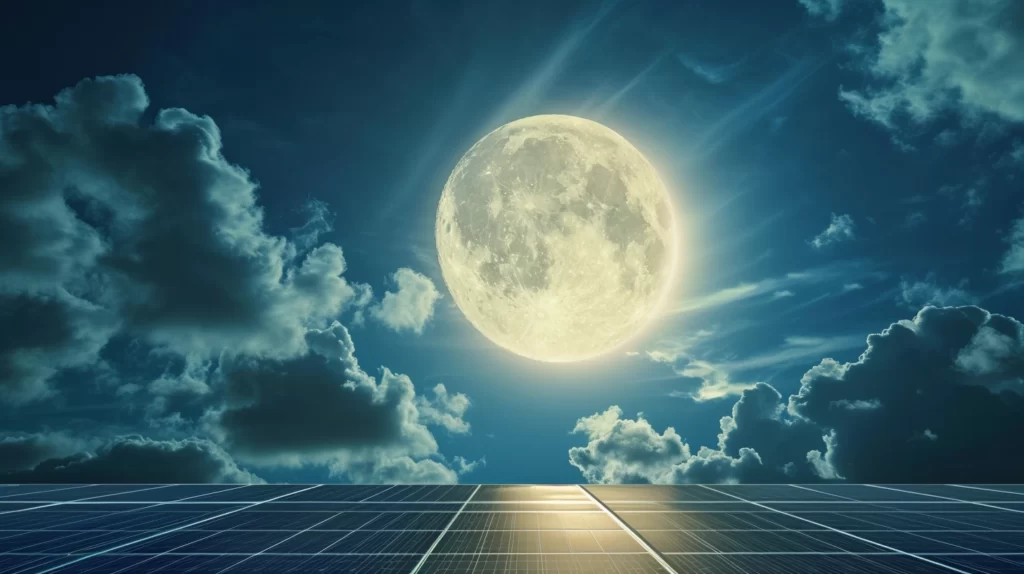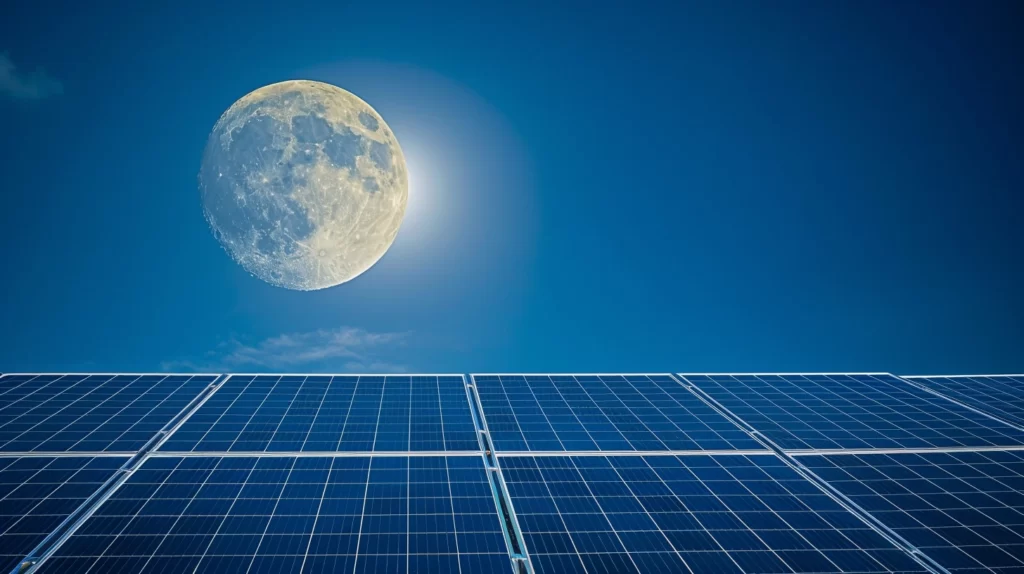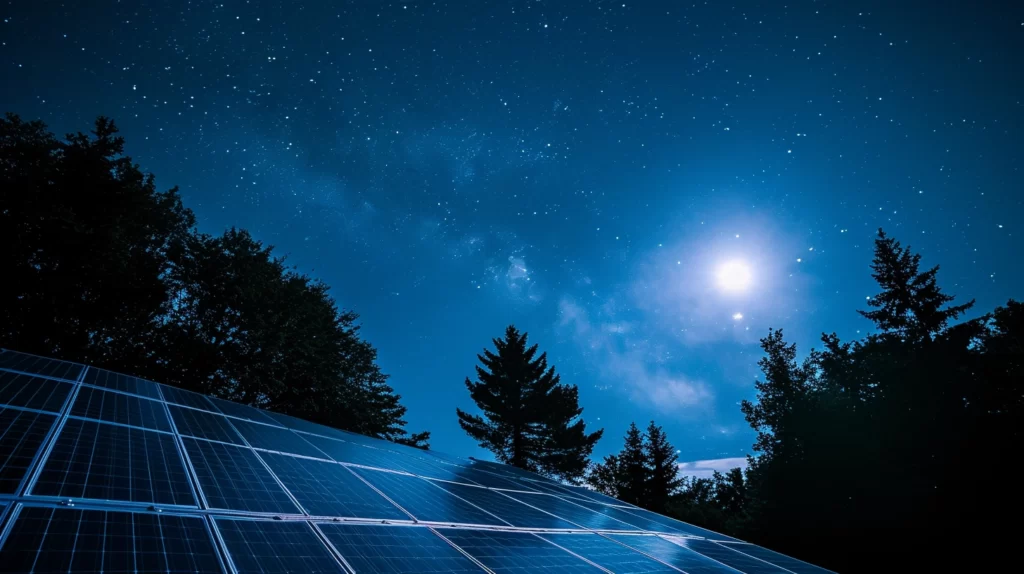Do Solar Panels Work with Moonlight? Crazy Moon Light Facts!
As the moon whispers its pale nocturnal sonnet, I can’t help but ponder whether its soft luminescence can dance with the technology of solar panels to create energy. I’m well aware that the moon’s light is but a faint echo of the sun, yet the question of its potential to power solar cells is a discussion worth exploring with both curiosity and a professional lens.
The science behind solar panels hinges on their ability to convert sunlight into electricity, but as the night drapes its cloak over the world, do these silent guardians of renewable energy stand completely dormant or do solar panels work with moonlight?
Continue Reading to Understand These Key Points:
- Moonlight is not strong enough to effectively power solar panels.
- Solar panels are optimized for sunlight absorption, not moonlight.
- Solar panel efficiency plummets at night due to the absence of sunlight.
- Artificial light can be more effective for solar energy generation than natural moonlight.
Moonlight’s Impact on Solar Panels
While moonlight does provide some energy, its impact on solar panel charging is minimal due to its significantly lower intensity compared to direct sunlight.
It’s important to understand that moonlight is simply reflected sunlight, and this secondhand source isn’t strong enough to effectively power solar panels. During a full moon, when moonlight is at its strongest, the energy it offers is still insufficient to charge solar panels in a manner that’s practical for nighttime use.

Analyzing the technical aspects, solar panels are designed to capitalize on the broad spectrum and high energy levels of sunlight. Moonlight, despite being the same in spectral composition, is much lower in intensity—about 1/345,000 that of the sun’s rays.
This substantial difference means that solar panels can operate at night only in a very limited capacity, if at all.
The concept of using moonlight to power solar is often seen as a charming idea, but the reality is rooted in physics. The energy yield from moonlight is so small that it’s not considered a viable option for nighttime power.
To maintain a power supply after dusk, solar energy systems typically rely on stored energy from solar batteries or net metering, rather than the faint glow of the moon.
Comparing Moonlight and Sunlight
In analyzing the energy potential of moonlight versus sunlight for solar panel use, it’s clear that the meager 0.0034 watts per square meter provided by lunar illumination is significantly less than the robust 1,368 watts per square meter delivered by direct sunlight.
This stark difference is crucial when considering solar panels as an energy source.
- Intensity of light: Sunlight is overwhelmingly more intense than moonlight, hence more effective at generating solar energy.
- Energy conversion: Solar panels are designed to harness sunlight efficiently; moonlight’s weak energy is mostly negligible.
- Reliability: Sunlight is a consistent and predictable energy source, unlike the variable and much weaker moonlight.
- Technological design: Solar panels are optimized for sunlight absorption, not the faint glow of the moon.
- Economic feasibility: Relying on moonlight for solar energy wouldn’t be cost-effective due to its insufficient power output.
As someone interested in the technical aspects of renewable energy, I find it fascinating how solar panels, although capable of capturing some energy from moonlight, are far from being an effective tool for harnessing lunar energy. The science behind it’s clear: solar panels need the powerful rays of the sun to be a viable energy source.
Solar Panel Efficiency at Night

Acknowledging the limitations of moonlight in solar energy production leads us to examine solar panel efficiency during the nighttime hours.
Despite the romantic notion of using the moon’s glow to power our lives, the reality is that solar panels are engineered to convert sunlight, which is vastly more potent than moonlight. At night, the absence of sunlight means that solar panel efficiency plummets.
Solar panels require direct sunlight to generate a significant amount of power, and their ability to capture energy from moonlight is marginal at best.
Moonlight offers only a fraction of the sun’s energy, and solar panels are not designed to harness this minimal power effectively. Consequently, solar energy systems are not productive at night under moonlight alone.
To illustrate, here’s a table comparing different aspects of solar energy capture:
| Aspect | Daylight Conditions | Nighttime Conditions |
|---|---|---|
| Light Intensity | High (Direct Sunlight) | Low (Moonlight) |
| Solar Panel Efficiency | Optimized | Significantly Reduced |
| Energy Production | Sufficient for Powering | Negligible |
For off-grid applications or those seeking energy autonomy during the night, the solution often lies in energy storage. Portable solar batteries can store excess energy generated during the day, providing a buffer that maintains the electricity supply after sunset.
Net metering is another method, allowing homeowners to feed surplus daytime energy back to the grid and draw from it at night.
Artificial Light Versus Natural Moonlight
Comparing artificial light sources to natural moonlight reveals stark contrasts in their potential to power solar panels. While both aren’t as potent as sunlight, it’s clear that the energy output from natural moonlight is insufficient to significantly charge solar panels due to its extreme weakness compared to sunlight.
Here are some key points to consider:
- Intensity: Artificial light can be more intense than natural moonlight, making it somewhat more effective for solar energy generation.
- Wavelength: Certain artificial lights emit wavelengths that solar panels can capture more efficiently than the broad spectrum of moonlight.
- Consistency: Artificial light sources can provide a steady supply of light, unlike moonlight which is variable and dependent on lunar phases.
- Proximity: Solar panels are often closer to artificial light sources like streetlights, which may increase the potential for energy capture.
- Optimization: While optimizing the placement and cleaning of solar panels is crucial for efficiency, it has a pronounced effect on energy harvest from artificial light due to its higher intensity.
Maximizing Solar Panel Performance

To maximize solar panel performance, careful consideration of installation angles, regular maintenance, and precise adjustments to tilt and orientation are crucial for optimal sunlight absorption.
It’s not just about placing panels on a roof; it’s about calculating the best position to capture the maximum amount of solar energy. One watt of solar energy may seem insignificant, but when multiplied across an entire array, the numbers become significant.
Maximizing solar panel performance isn’t a one-time task, it’s an ongoing process that requires attention to detail. Here’s a table that summarizes the key practices:
| Factor | Importance |
|---|---|
| Installation Angle | Ensures panels are aligned with the sun’s path |
| Regular Cleaning | Removes obstructions like dust and debris |
| Tilt and Orientation Adjustments | Optimizes angle throughout the year |
| Monitoring Performance | Identifies and rectifies inefficiencies |
| Technological Upgrades | Keeps system at peak efficiency |
Each of these components contributes to the overall efficiency of a solar array. By systematically applying these practices, I can ensure that I’m harnessing the sun’s energy during the day in the most effective manner possible, thereby maximizing solar panel performance.
Final Thoughts
Expecting solar panels to thrive under the glow of the moon is like hoping to tan during a midnight stroll—it’s just not in the cards.
Moonbeams, while enchanting, pack a pitiful punch compared to the sun’s fiery might, barely tickling the surface of our solar sentinels.
So, when night falls, let’s not kid ourselves; it’s the sun’s blockbuster energy that solar panels crave, leaving moonlight as a mere whisper in the realm of renewable power.
